Input interpretation

HCl (hydrogen chloride) + NH_3 (ammonia) ⟶ NH_4Cl (ammonium chloride)
Balanced equation
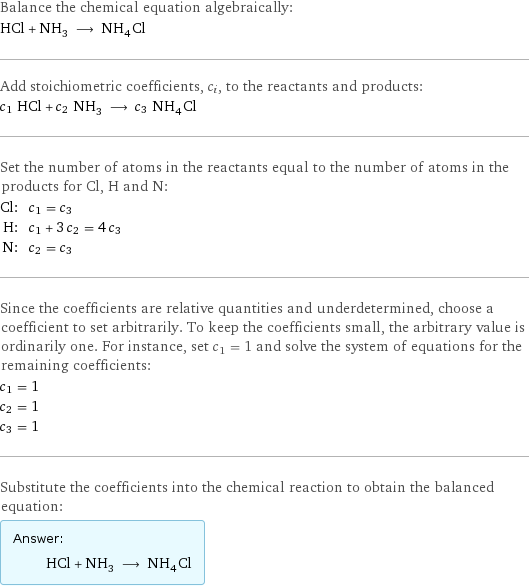
Balance the chemical equation algebraically: HCl + NH_3 ⟶ NH_4Cl Add stoichiometric coefficients, c_i, to the reactants and products: c_1 HCl + c_2 NH_3 ⟶ c_3 NH_4Cl Set the number of atoms in the reactants equal to the number of atoms in the products for Cl, H and N: Cl: | c_1 = c_3 H: | c_1 + 3 c_2 = 4 c_3 N: | c_2 = c_3 Since the coefficients are relative quantities and underdetermined, choose a coefficient to set arbitrarily. To keep the coefficients small, the arbitrary value is ordinarily one. For instance, set c_1 = 1 and solve the system of equations for the remaining coefficients: c_1 = 1 c_2 = 1 c_3 = 1 Substitute the coefficients into the chemical reaction to obtain the balanced equation: Answer: | | HCl + NH_3 ⟶ NH_4Cl
Structures
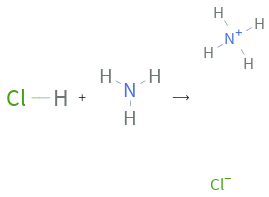
+ ⟶
Names

hydrogen chloride + ammonia ⟶ ammonium chloride
Reaction thermodynamics
Enthalpy

| hydrogen chloride | ammonia | ammonium chloride molecular enthalpy | -92.3 kJ/mol | -45.9 kJ/mol | -314.4 kJ/mol total enthalpy | -92.3 kJ/mol | -45.9 kJ/mol | -314.4 kJ/mol | H_initial = -138.2 kJ/mol | | H_final = -314.4 kJ/mol ΔH_rxn^0 | -314.4 kJ/mol - -138.2 kJ/mol = -176.2 kJ/mol (exothermic) | |
Gibbs free energy
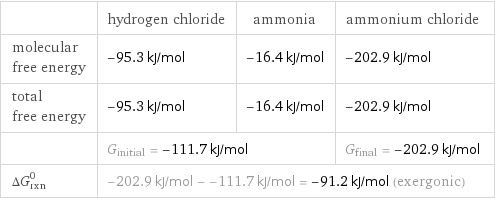
| hydrogen chloride | ammonia | ammonium chloride molecular free energy | -95.3 kJ/mol | -16.4 kJ/mol | -202.9 kJ/mol total free energy | -95.3 kJ/mol | -16.4 kJ/mol | -202.9 kJ/mol | G_initial = -111.7 kJ/mol | | G_final = -202.9 kJ/mol ΔG_rxn^0 | -202.9 kJ/mol - -111.7 kJ/mol = -91.2 kJ/mol (exergonic) | |
Entropy
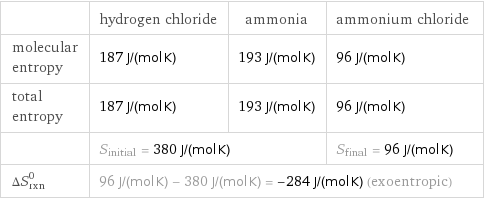
| hydrogen chloride | ammonia | ammonium chloride molecular entropy | 187 J/(mol K) | 193 J/(mol K) | 96 J/(mol K) total entropy | 187 J/(mol K) | 193 J/(mol K) | 96 J/(mol K) | S_initial = 380 J/(mol K) | | S_final = 96 J/(mol K) ΔS_rxn^0 | 96 J/(mol K) - 380 J/(mol K) = -284 J/(mol K) (exoentropic) | |
Equilibrium constant
![Construct the equilibrium constant, K, expression for: HCl + NH_3 ⟶ NH_4Cl Plan: • Balance the chemical equation. • Determine the stoichiometric numbers. • Assemble the activity expression for each chemical species. • Use the activity expressions to build the equilibrium constant expression. Write the balanced chemical equation: HCl + NH_3 ⟶ NH_4Cl Assign stoichiometric numbers, ν_i, using the stoichiometric coefficients, c_i, from the balanced chemical equation in the following manner: ν_i = -c_i for reactants and ν_i = c_i for products: chemical species | c_i | ν_i HCl | 1 | -1 NH_3 | 1 | -1 NH_4Cl | 1 | 1 Assemble the activity expressions accounting for the state of matter and ν_i: chemical species | c_i | ν_i | activity expression HCl | 1 | -1 | ([HCl])^(-1) NH_3 | 1 | -1 | ([NH3])^(-1) NH_4Cl | 1 | 1 | [NH4Cl] The equilibrium constant symbol in the concentration basis is: K_c Mulitply the activity expressions to arrive at the K_c expression: Answer: | | K_c = ([HCl])^(-1) ([NH3])^(-1) [NH4Cl] = ([NH4Cl])/([HCl] [NH3])](../image_source/5266865fbd548f57981e07e8baeedddf.png)
Construct the equilibrium constant, K, expression for: HCl + NH_3 ⟶ NH_4Cl Plan: • Balance the chemical equation. • Determine the stoichiometric numbers. • Assemble the activity expression for each chemical species. • Use the activity expressions to build the equilibrium constant expression. Write the balanced chemical equation: HCl + NH_3 ⟶ NH_4Cl Assign stoichiometric numbers, ν_i, using the stoichiometric coefficients, c_i, from the balanced chemical equation in the following manner: ν_i = -c_i for reactants and ν_i = c_i for products: chemical species | c_i | ν_i HCl | 1 | -1 NH_3 | 1 | -1 NH_4Cl | 1 | 1 Assemble the activity expressions accounting for the state of matter and ν_i: chemical species | c_i | ν_i | activity expression HCl | 1 | -1 | ([HCl])^(-1) NH_3 | 1 | -1 | ([NH3])^(-1) NH_4Cl | 1 | 1 | [NH4Cl] The equilibrium constant symbol in the concentration basis is: K_c Mulitply the activity expressions to arrive at the K_c expression: Answer: | | K_c = ([HCl])^(-1) ([NH3])^(-1) [NH4Cl] = ([NH4Cl])/([HCl] [NH3])
Rate of reaction
![Construct the rate of reaction expression for: HCl + NH_3 ⟶ NH_4Cl Plan: • Balance the chemical equation. • Determine the stoichiometric numbers. • Assemble the rate term for each chemical species. • Write the rate of reaction expression. Write the balanced chemical equation: HCl + NH_3 ⟶ NH_4Cl Assign stoichiometric numbers, ν_i, using the stoichiometric coefficients, c_i, from the balanced chemical equation in the following manner: ν_i = -c_i for reactants and ν_i = c_i for products: chemical species | c_i | ν_i HCl | 1 | -1 NH_3 | 1 | -1 NH_4Cl | 1 | 1 The rate term for each chemical species, B_i, is 1/ν_i(Δ[B_i])/(Δt) where [B_i] is the amount concentration and t is time: chemical species | c_i | ν_i | rate term HCl | 1 | -1 | -(Δ[HCl])/(Δt) NH_3 | 1 | -1 | -(Δ[NH3])/(Δt) NH_4Cl | 1 | 1 | (Δ[NH4Cl])/(Δt) (for infinitesimal rate of change, replace Δ with d) Set the rate terms equal to each other to arrive at the rate expression: Answer: | | rate = -(Δ[HCl])/(Δt) = -(Δ[NH3])/(Δt) = (Δ[NH4Cl])/(Δt) (assuming constant volume and no accumulation of intermediates or side products)](../image_source/07fd0e7c89863a9b15fc5fe53812da2f.png)
Construct the rate of reaction expression for: HCl + NH_3 ⟶ NH_4Cl Plan: • Balance the chemical equation. • Determine the stoichiometric numbers. • Assemble the rate term for each chemical species. • Write the rate of reaction expression. Write the balanced chemical equation: HCl + NH_3 ⟶ NH_4Cl Assign stoichiometric numbers, ν_i, using the stoichiometric coefficients, c_i, from the balanced chemical equation in the following manner: ν_i = -c_i for reactants and ν_i = c_i for products: chemical species | c_i | ν_i HCl | 1 | -1 NH_3 | 1 | -1 NH_4Cl | 1 | 1 The rate term for each chemical species, B_i, is 1/ν_i(Δ[B_i])/(Δt) where [B_i] is the amount concentration and t is time: chemical species | c_i | ν_i | rate term HCl | 1 | -1 | -(Δ[HCl])/(Δt) NH_3 | 1 | -1 | -(Δ[NH3])/(Δt) NH_4Cl | 1 | 1 | (Δ[NH4Cl])/(Δt) (for infinitesimal rate of change, replace Δ with d) Set the rate terms equal to each other to arrive at the rate expression: Answer: | | rate = -(Δ[HCl])/(Δt) = -(Δ[NH3])/(Δt) = (Δ[NH4Cl])/(Δt) (assuming constant volume and no accumulation of intermediates or side products)
Chemical names and formulas

| hydrogen chloride | ammonia | ammonium chloride formula | HCl | NH_3 | NH_4Cl Hill formula | ClH | H_3N | ClH_4N name | hydrogen chloride | ammonia | ammonium chloride
Substance properties
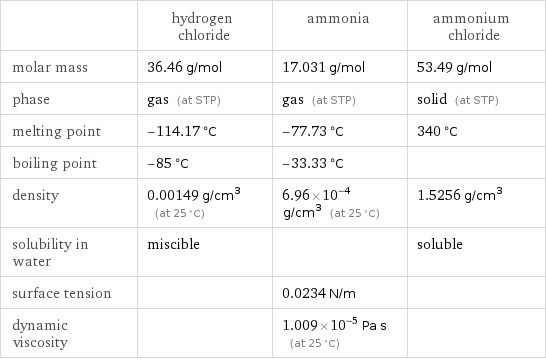
| hydrogen chloride | ammonia | ammonium chloride molar mass | 36.46 g/mol | 17.031 g/mol | 53.49 g/mol phase | gas (at STP) | gas (at STP) | solid (at STP) melting point | -114.17 °C | -77.73 °C | 340 °C boiling point | -85 °C | -33.33 °C | density | 0.00149 g/cm^3 (at 25 °C) | 6.96×10^-4 g/cm^3 (at 25 °C) | 1.5256 g/cm^3 solubility in water | miscible | | soluble surface tension | | 0.0234 N/m | dynamic viscosity | | 1.009×10^-5 Pa s (at 25 °C) |
Units
